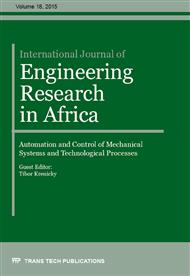[1]
J.M. Hopen, A. Hošovský, The Servo Robustification of the Industrial Robot, in: Annals of DAAAM for 2005, DAAAM International, Vienna, 2005, pp.161-162.
Google Scholar
[2]
Hošovský, M. Havran, Dynamic Modeling of One Degree of Freedom Pneumatic Muscle-Based Actuator for Industrial Applications, Tehnički Vjesnik 3/19 (2012) 673-681.
Google Scholar
[3]
K. Židek, O. Líška, V. Maxim, Rehabilitation Device Based on Unconventional Actuator, Mechatronics: Recent Technological and Scientific Advances, Springer, Berlin, 2011, pp.697-702.
DOI: 10.1007/978-3-642-23244-2_84
Google Scholar
[4]
O. Líška, M. More, D. Janáčová, H. Charvátová, Design of Rehabilitation Robot Based on Pneumatic Artificial Muscles. Mathematical Methods and Optimization Techniques in Engineering, WSEAS Press, 2013, pp.151-154.
Google Scholar
[5]
J. Mižáková, J. Piteľ, M. Tóthová, Pneumatic Artificial Muscle as Actuator in Mechatronic System, Applied Mechanics and Materials 460 (2014) 81-90.
DOI: 10.4028/www.scientific.net/amm.460.81
Google Scholar
[6]
M. Tóthová, Modeling and Simulation of Dynamics of Nonconventional Pneumatic Actuator of Manipulator; Dissertation, FMT TUKE, Prešov, (2014).
Google Scholar
[7]
M. Tóthová, Simulation Model of Pneumatic Actuator Based on Artificial Muscles, in: Proc. of Conference IMAP 2013, TUKE, Prešov, 2013, pp.65-69.
Google Scholar
[8]
M. Tóthová, Simulation of Pneumatic Muscle Actuator Dynamics, in: Proceedings of 1st Biannual Comparative European Research Conference (CER 2014), London, 2014, pp.109-112.
Google Scholar
[9]
Tondu, P. Lopez, Modeling and Control of Mckibben Artificial Muscle Robot Actuators, IEEE Control Systems Magazine 20/2 (2000) 15-38.
DOI: 10.1109/37.833638
Google Scholar
[10]
A. Hošovský, P. Michal, M. Tóthová, O. Biroš, Fuzzy Adaptive Control for Pneumatic Muscle Actuator with Simulated Annealing Tuning, in: Proc. of 12th IEEE Int. Symp. on Applied Machine Intelligence and Informatics (SAMI 2014), IEEE, Budapest, 2014, pp.205-209.
DOI: 10.1109/sami.2014.6822408
Google Scholar
[11]
J. Boržíková, M. Balara, Mathematical Model of Contraction Characteristics of the Artificial Muscle, Manufacturing Engineering 6/2 (2007) 26-29.
Google Scholar
[12]
M. Balara, M. Tóthová, Static and Dynamic Properties of the Pneumatic Actuator with Artificial Muscles, in: Proc. of IEEE 10th Jubilee Int. Symp. on Intelligent Systems and Informatics (SISY 2012), IEEE, Subotica, 2012, pp.577-581.
DOI: 10.1109/sisy.2012.6339483
Google Scholar
[13]
A. Hošovský, K. Židek, Experimental Validation of Nominal Model Characteristics for Pneumatic Muscle Actuator, Applied Mechanics and Materials 460 (2014) 1-12.
DOI: 10.4028/www.scientific.net/amm.460.1
Google Scholar
[14]
M. Tóthová, S. Hrehová, Dynamic Characteristics of the Antagonistic Pneumatic Muscle Actuator for Biomechanical Applications, in: Proc. of 2nd Int. Conf. on Sensors and Materials Manufacturing Science (ICSMMS 2015), BOSI EDU, Paris, (2015).
Google Scholar
[15]
M. Tóthová, A. Hošovský, Dynamic Simulation Model of Pneumatic Actuator with Artificial Muscle, in: Proc. of 11th IEEE Int. Symp. on Applied Machine Intelligence and Informatics (SAMI 2013), IEEE, Budapest, 2013, pp.47-51.
DOI: 10.1109/sami.2013.6480994
Google Scholar
[16]
M. Tóthová, Simulation of the Pneumatic Actuator with Artificial Muscles Using Modified Hill´s Muscle Model, in: Proc. of Automation in Theory and Practice (ARTEP 2013), TUKE, Košice, 2013, 41-1-8.
Google Scholar
[17]
M. Tóthová, Simulation of the Pneumatic Actuator Dynamics Using Advanced Geometric Model of Artificial Muscle. Proceedings of Automation in Theory and Practice (ARTEP 2014), TUKE, Košice, 2014, 22-1-8.
Google Scholar
[18]
T. Kerscher, J. Albiez, J.M. Zollner, R. Dillmann, Evaluation of the Dynamic Model of Fluidic Muscles using Quick-Release, in: Proceedings of the BioRob 2006, Pisa, 2006, pp.637-642.
DOI: 10.1109/biorob.2006.1639161
Google Scholar
[19]
F. Daerden, Conception and Realization of Pleated Pneumatic Artificial Muscles and their Use as Compliant Actuation Elements, Vrije Universiteit, Brussel, (1999).
Google Scholar
[20]
J. Sárosi, I. Bíró, J. Németh, L. Cveticanin, Dynamic Modelling of a Pneumatic Muscle Actuator with Two-direction Motion, Mechanism and Machine Theory 85 (2015) 25-34.
DOI: 10.1016/j.mechmachtheory.2014.11.006
Google Scholar
[21]
K. Lamár, G.A. Kocsis, Implementation of Speed Measurement for Electrical Drives Equipped with Quadrature Encoder in LabVIEW FPGA, Acta Technica Corviniensis - Bulletin of Engineering 6/4 (2013) 123-126.
Google Scholar
[22]
Z. Murčinková, T. Krenický, Implementation of Virtual Instrumentation for Multiparametric Technical System Monitoring, in: Proc. of the SGEM 2013, STEF92 Technology, Sofia, 2013, pp.139-144.
Google Scholar
[23]
N.S. Bao, S.L. Fei, X.J. Huang, T.Q. Liu, J. Huang, Labview-Based Automatic Four-Axis Positioning Control Air Temperature and Wind Speed Detection Platform for Drying Oven, Advanced Materials Research 718-720 (2013) 1547-1553.
DOI: 10.4028/www.scientific.net/amr.718-720.1547
Google Scholar


